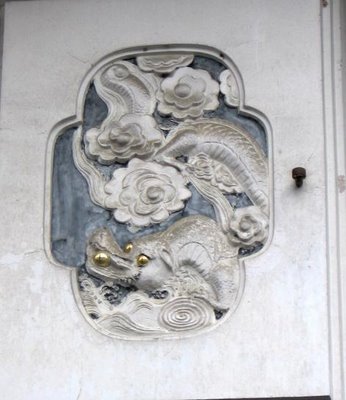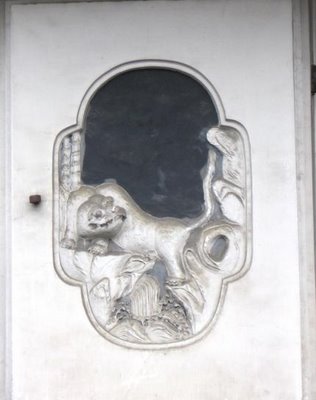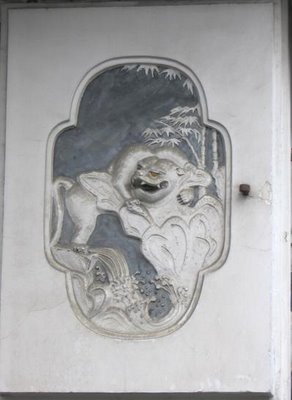[ . BACK to DARUMA MUSEUM TOP . ]
. shokunin 職人 craftsman, craftsmen, artisan, Handwerker .
. Places and Powerspots of Edo .
:::::::::::::::::::::::::::::::::::::::::::::::::::::::::::::::::::::::::::::::::::::::::::::::::::::::::::::::::::::::::::::::::::::::::::::::::::::::::::::::::::::::::::::::::::::
daiku 大工 carpenter and legends
. daiku - Introducing Japanese Carpenters .
 CLICK for more photos !
江戸時代大工上棟之図 Edo Carpenters building a roof
tooryoo 棟梁 Toryo, master carpenter
CLICK for more photos !
江戸時代大工上棟之図 Edo Carpenters building a roof
tooryoo 棟梁 Toryo, master carpenter
He is a most important person when building a new wooden home, temple or shrine.
They also had the job of an architect in planning and organizing the whole construction.
miyadaiku 宮大工 "shrine carpenter"
specializing in building shrines and palaces
. Hida no takumi 飛騨の匠 master builders from Hida, Gifu .
an expert carpenter or craftsman from Hida
Hida no daiku 飛騨の大工 carpenter from Hida, architect from Hida
..............................................................................................................................................
There was a special district in Edo where most of the carpenters lived :
Kanda daikuchoo 神田 大工町 carpenter district in Kanda
tate daikuchoo 竪大工町 (now in Uchi Kanda 内神田三丁目14番 )
yoko daikuchoo 横大工町 / minami daikuchoo 南大工町
This district was founded around 1640 in the Kanei period 寛永 and is mentioned in the
"Edo Map of Kanei 寛永江戸図".
Many carpenters who lived here worked directly for the Bakufu government for the official buildings of Edo.
 source : 無涯塾日記
source : 無涯塾日記
One famous (but fictional) character is the carpenter 吉五郎
Kichigoro in the story
三方一両損
sanbo ichiryo zon, where the famous magistrate 大岡越前守忠相 Oka Echizen is holding court.
The shop of a craftsman making the
matoi 纏 standards , a pole with the fire fighters brigade mark, is also located here.
纏屋治郎右衛門 Matoiya Jiroemon
. shokuninmachi 職人町 district with craftsmen in Edo .
Now the 龍谷大学 Ryukoku University is located in this district.
.......................................................................
Another district where carpenters lived was
 Umibedaikuchmachi 海辺大工町 Umibe Daikumachi carpenter district on the coast
Umibedaikuchmachi 海辺大工町 Umibe Daikumachi carpenter district on the coast
Umibe Daikucho, Umibe Daiku-Cho , Umibe Daiku-machi
along the river 小名木川
Onagigawa.

Umibe is a district in 江東区 Koto Ward, next to Fukagawa.
River Onagigawa joins the Sumidagawa with the bridge 高橋
Takahashi as main access. Another bridge was 万年橋
Mannenbashi and then
the
Shin-Takahashi 新高橋 New Takahashi Bridge. The bridge Takahashi (
High Bridge) was build much higher than other bridges to avoid being swept away by flooding of the rivers.
After reclaiming the land the settlement along the river Onagigawa became w river port and was named Umibe Daikumachi in 1713.

Many carpenters skilled in building ships and boats came to live here, hence the name.
funadaiku 船大工 shipbuilder carpenter

The bottom of a wooden boat was often burned to make it more resistant to rotting.
 source : adachi-hanga.com/ukiyo-e
source : adachi-hanga.com/ukiyo-e
歌川国芳 Utagawa Kuniyoshi
Detail from 東都三ツ股の図 Toto Mitsumata no Zu
View of Mitsumata in the Eastern Capital
 . River Onagigawa 小名木川 .
. River Onagigawa 小名木川 .
and The Gyotoku Salt Fields 行徳塩田 Gyotoku enden
.......................................................................
- - - - -
. Bashō-An 芭蕉庵 Basho-An in Fukagawa 深川 .
- Matsuo Basho 松尾芭蕉 - Haiku Poet
 source : homepage3.nifty.com/onihei-zue
source : homepage3.nifty.com/onihei-zue
Basho-An was near the
Mannenbashi 万年橋
"Ten Thousand Year Bridge".
萬年橋 Mannenbashi bridge - Hiroshige
:::::::::::::::::::::::::::::::::::::::::::::::::::::::::::::::::::::::::::::::::::::::::::::::::::::::::::::::::::::::::::::::::::::::::::::::::::::::::::::::::::::::::::::::::::::
 source : 刃物 フルカワ
source : 刃物 フルカワ
職人絵図 江戸時代 大工 (釿・ノミ・鋸・下げ振りなどが見える)
Craftsmen going out to work were called
dejoku, deshoku 出職.
They went to the home of a client to work. The three most important deshoku for construction works 普請三職 were
大工 carpenter, shakan 左官 wall plasterer and tobi 鳶 construction workers.
..............................................................................................................................................
The carpenters left home early in the morning to make use of the daylight. Work usually started around 7:00 in the morning
They carried a box with their tools, an important status symbol of each carpenter.
He always kept the box at home over night. If a fire broke out in the neighbourhood he could throw his tool box into the drainage canal before the house (どぶ). So even if he lost his home and place to sleep, he still had his tools and could start all anew the next day.
 source and more : たそがれ日記
doogubako 道具箱 Dogubako, tool box of a carpenter
source and more : たそがれ日記
doogubako 道具箱 Dogubako, tool box of a carpenter
At 10:00 there was a short break of about 30 minutes.
13:00 was time for a one-hour lunch break.
At 14:00, another short break of about 30 minutes. Including a smoke and a snack.
At 17:00 work was over and the carpenter could go home. On the way he might go to a bath house and be home at 19:00 for dinner.
Bedtime was early, at 20:00.
(There was no electric light in Edo . . . nights were dark, dark, dark.)
If he had to start earlier or work overtime to get a job done, he was payed extra money.
Because of bad weather he usually could not work for about 60 days in a year, leaving him without income for 2 months. His wife had to make ends meet.
He still had enough pocket money to have a drink of Sake at night and get some sweets for the children.
There was a humorous saying in Edo:
大工殺すにゃ刃物はいらぬ、雨の十日も降ればよい.
To kill a carpenter you do not need a sharp blade.
Just let it rain for 10 days.
Before doing some work the craftsman had to haggle about the price for a bit of work with his client,
temadori 手間取.
:::::::::::::::::::::::::::::::::::::::::::::::::::::::::::::::::::::::::::::::::::::::::::::::::::::::::::::::::::::::::::::::::::::::::::::::::::::::::::::::::::::::::::::::::::::
Kiba 木場
 CLICK for more photos !
- quote -
Kiba - Lumberyards and Carpenters
CLICK for more photos !
- quote -
Kiba - Lumberyards and Carpenters
Eitai-bashi (Eitai bridge) is the longest bridge in Edo, and one of the largest in the country. Though not nearly as famous as nearby Nihonbashi, it is probably a more important bridge for the citizens of Edo. The huge, semicircular arch is one of just three bridges spanning the lower reaches of the Sumida river, and linking central Edo with the residential and manufacturing districts on the eastern shore of the river. Although both Nihonbashi and Ryogoku-bashi are more well known, Eitai-bashi is nevertheless an important transportation link from central Edo to the busy lumberyards of Kiba.
Kiba is a low-lying district on the very edge of Edo bay, on the east bank of the Sumida river. It is a very blue-collar neighborhood, and most of the residents live in nagaya (row houses). Many of the people who live here are day laborers and construction workers, who toil in the vast lumberyards that give this district its name.
The word "kiba" literally means "
place for wood". The area gets its name because it is the neighborhood designated by the Shogun for all lumber yards. Although many construction companies have offices in the central part of the city, they are prohibited from keeping a large stockpile of wood anywhere near the city center. Instead, they have to keep almost all of their wood stored in Kiba. This is a precaution taken to help prevent serious fires.
When Edo was first built, the main kiba, or lumber yards, were located on the west bank of the Sumida river, in places like Tsukiji and Hamacho. This was the most convenient location, since the wood could be transported there easily by river, and most of the construction work being done in the city was in the downtown areas around Nihonbashi, Kyobashi and Kanda. As the city began to spread out, construction companies set up smaller lumber yards in each part of the city. However, as the people of Edo discovered, this was an invitation to disaster. Fire has always been a serious problem for citizens of Edo. Nearly every building in the city is made of wood, and the houses are packed tightly together, especially in the shitamachi (downtown) areas of the city. If a fire gets started, it usually spreads very fast, and it may destroy many, many buildings before anyone can put it out.
In the crowded, narrow streets of the city, it is often hard to escape from a fire, and many people die every year from even small fires. There is even an old saying among city residents, that "fires and fistfights are the flowers of Edo". Both types of altercations flare up very easily in the crowded downtown neighborhoods. However, when they were planning and building their city, the early Shoguns never imagined that fires could cause as much damage as the
Great Meireki Fire did in 1657.
The Great Meireki Fire was the worst catastrophe ever to strike the city, and even today, more than a century later, the city still bears scars from the disaster. Almost half a million people died in the flames, and over half of the city was burned to the ground. After the catastrophe was over, Tokugawa Tsunayoshi, the fifth Shogun, passed a series of laws and made several changes to the design of the city to help make sure that future fires could not spread so quickly or cause as much damage. One reason why the flames to spread rapidly was that there were many large lumber yards located in the downtown area. Once a big lumber yard catches fire, it is just about impossible to put out, and the flames jump so high that the firemen cannot stop them from spreading to other buildings nearby.
After the Great Meireki Fire, all carpenters and builders were ordered to move their lumber yards to the other side of the river, away from the heavily populated downtown area. The new neighborhood was given the name "Kiba". A number of other changes were made as well, such as widening the roads to create firebreaks, and organising local fire brigades. The job of a fireman is usually held by low-ranking samurai. It is a very dangerous and demanding job, but the firemen of Edo are highly respected, and many local communities look to current or former members of the fire brigade to become their local leaders and peace officers.

Kiba is a very low, swampy area that sometimes gets flooded at extremely high tides and during storms. Although this makes it a rather uncomfortable place to live, it is an ideal place for lumber yards. First of all, it was easy to build a vast network of canals in the area where the lumber yards were located. These canals have a dual purpose -- their main function is as transportation routes, to make it easier to bring wood to and from the lumber yards. In addition, the canals prevent fires from spreading from lumber yard to lumber yard. Although the high tides and floods can sometimes cause damage to the wood (especially if the wood remains under water for too long), it also has a positive effect. Termites cannot build their nests in swampy ground, and the occasional floods destroy any termite nests that have been established in the woodpiles, so the lumber yards of Kiba are almost immune to termite damage.

Wood is brought to Kiba from mountain forests far to the north and west of the city. Lumberjacks working in the forests cut down the tall, straight and hard-wooded trees such as sugi (cedar) and hinoki (cypress). These are the best types of wood for building houses, since the wood is straight, strong and very resistant to water. The logs are then cut into large, semifinished beams, which are tied together like a raft and transported downriver to Edo.
When the huge wooden beams reach Kiba, they are sold to individual lumber merchants or construction companies. The lumber merchants take the huge beams to their own lumber yard where carpenters saw them up into smaller boards and beams, storing them in the lumber yards until they are ready to use.
Most of the lumber merchants have close ties to the construction guilds in downtown Edo. Builders are among the more respected of craftsmen, and master builders can become very wealthy. However, for every master architect and builder, there are usually many lesser craftsmen, apprentices and day laborers who do the dirty work, like carrying heavy beams or bundles of shingles to and from a building site, or tearing down old buildings that are being replaced. The more skilled carpenters tend to live in middle-class areas in
Nihonbashi, Kyobashi or Asakusa, while many lower-level workers live in the blue-collar districts near Kiba, where they queue up each day looking for temporary jobs on a construction site.
- source : edomatsu -
. Construction work - Introduction .
Organizing all the artisans to build a home in Edo !
. Kawase Hasui 川瀬巴水 (1883 - 1957) .
 Kiba no Yugure 木場の夕暮れ Timber Yard, Evening
Kiba no Yugure 木場の夕暮れ Timber Yard, Evening
:::::::::::::::::::::::::::::::::::::::::::::::::::::::::::::::::::::::::::::::::::::::::::::::::::::::::::::::::::::::::::::::::::::::::::::::::::::::::::::::::::::::::::::::::::::
. carpenter tools with Daruma .
 koshibukuro だるまの腰袋 waist bag
koshibukuro だるまの腰袋 waist bag
kugibukuro 釘袋 nail bag
. kugi 釘 nail, Nagel - Introduction .
:::::::::::::::::::::::::::::::::::::::::::::::::::::::::::::::::::::::::::::::::::::::::::::::::::::::::::::::::::::::::::::::::::::::::::::::::::::::::::::::::::::::::::::::::::::
Daiku Rokusa 大工六三 Rokusa the Carpenter
?Daiku Rokuzo, Daiku Rokuzō

Utagawa Kunisada
A portrait of Ichikawa Ichizo III as Rokusaburo the carpenter,
made for the forthcoming performances of Komamukae Tanomino Tsukkomi (a version of Mijikayo ukina no chirashigaki) at the Morita theatre in 1858.
- source : fitzmuseum.cam.ac.uk/gallery -
- quote -
OSONO ROKUSA
Sanzesô Nishiki Bunshô / Oku Dôsha Musume Sugegasa
The courtesan Osono, who belongs to the Fukushimaya house in Fukagawa, is ailing because of over-anxiety concerning her lover Komurasaki Rokusaburô (commonly called Rokusa). He has been dismissed from service as samurai because he lost a family treasure, a valuable poem card (shikishi) that had been entrusted to his keeping. .....
Osono's brother Chôan, a doctor who is more a charlatan than a skilled doctor, knows that Rokusa is a hopeless rônin. ...
... Osono, who is readying herself for departure, is met by Rokusa who has come back to kill her. Osono gives him a letter she had written to explain everything. Rokusa understands the circumstances and they go off together.
Trivia
The story of Osono and Rokusa is based on two real events which happened in Ôsaka in 1749: the 18th day of the 3rd lunar month of the 2nd year of the Kan'en era , the courtesan Osono (from the Minami pleasure district) and
the carpenter Rokusa committed a double suicide. The same day, a courtesan from the Kita Shinchi pleasures district, who had killed her elder brother and was sentenced to death, was executed. The story of Osono and Rokusa is a fusion of these two real events.
In Sakurada Jisuke III's version, the actions and characters are shifted to Edo.
- source : kabuki21.com -
:::::::::::::::::::::::::::::::::::::::::::::::::::::::::::::::::::::::::::::::::::::::::::::::::::::::::::::::::::::::::::::::::::::::::::::::::::::::::::::::::::::::::::::::::::::
. Legends and Tales from Japan 伝説 - Introduction .
.......................................................................
ishidooro 石燈篭 Ishidoro, stone lantern
元禄年中に寺を普請した棟梁が奉納した燈篭を江戸へ運ぼうとしたら、夜関係者が発熱し狂気のように皆燈篭のことを口走った。ゆえに江戸へは運ばず寺に返した。精霊が宿っているのだろう。
.......................................................................
kitsune 狐 fox
王子村稲荷は関八州の稲荷明神の棟梁で、毎年12月晦日に関八州の狐が社前に集まり火を灯す。その燃え方を見て周辺の人は作柄を占う。
................................................................................. Ehime 愛媛県
Joohen 城辺町 Johen
Wakamiya Jinja no ki 若宮神社の木
若宮神社には300年以上経った並木があったが、3年前に集会場を建てるので切り倒してしまった。その木を斬った棟梁は間もなく入院して亡くなり、他の樵も皆亡くなってしまった。
.......................................................................
大洲市
Ozu
yamaneko, yamainu 山猫,山犬
銃の名手左衛門が、山猫の住む「入らずの森」を開拓した。山猫は手出しができずにいたが、ある日娘が一夜の宿を求めて来て、左衛門は共に暮らした。ある日山犬に襲われた飛脚が「山猫の棟梁が左衛門のところに行っていなければ」と言うのを聞く。それが左衛門の耳にも入り、ついには正体を現した古猫をしとめる。
................................................................................. Hiroshima 広島県
funadamasama 船魂様 Funadama Sama
船魂様は女の神様で、女がひとりで乗船することを嫌う。ひとりで乗るときにはデコ(人形)を持って乗るとよいと言われている。船霊様として帆柱の下に収められるのはサイコロ2個と一文銭12枚、女のデコを1個である。サイコロは大工の棟梁が柳の木から新しく作ったもので、2と2の目が向かい合うように並べる。
................................................................................. Ishikawa 石川県
河内町 Kawachi
tengu 天狗
棟上げの時、天狗除けや魔除けのために、棟梁が屋根の上に六角の糸巻きの枠を立て、それに鯖をつるす。その後、鯖は川に流してしまうという。
................................................................................. Kagoshima 鹿児島県
大島郡
Oshima district
fuiguchi フイグチ
部落に住む大工の棟梁同士が喧嘩した際、ひとりの棟梁がフイグチをする性格であった。もうひとりの棟梁はそれを見抜いていてモドシグチを行った。するとクチを入れた棟梁は眠ったまま死んでしまった。
................................................................................. Kyoto 京都府
亀岡市
Kameoka
shironamazu 白鯰 White Namazu catfish
亀山城の別棟が少し歪んでいたので、棟梁が責任を取って堀に身を投げた。棟梁は白鯰となり、堀の主となった。水の浅くなった月の夜半、白鯰が頭を水面に出して城を見つめるという。
................................................................................. Miyagi 宮城県
栗駒町
Kurikoma
nyuudoo boozu 入道坊主 Nyudo Bozu
棟梁が着工式に呼ばれ、お祝いの魚を藁づとに包んで帰る途中、人気のない道で火にあたる八尺ばかりの入道坊主に会った。持っていた手斧をふりまわしながら通り過ぎたが、いつのまにか入道坊主は消えた。ムジナの仕業だという。
.......................................................................
柴田町 Shibata
amida no kakejiku 阿弥陀の掛軸
山の上集落の近江家は、旅の僧をもてなして阿弥陀様の書かれた掛軸をもらった。あるとき、近江家に普請に入った大工の頭領が、掛軸を盗んで逃げた。家を出た途端大雨が降り出し、狐狸が邪魔をした。雷が鳴り、橋が流れそうになる。命からがら家に帰ったが、掛軸はピカピカと光っていた。翌朝、棟梁はポックリ死んでしまった。掛軸は古道具屋に売り払われたが、今度は大きなネズミが出て道具屋が眠れない。祈祷師に拝んでもらうと元の家に返せという。こうして掛軸は返ってきた。
................................................................................. Osaka 大阪府
kaeruishi, kaeru ishi かえる石
大阪城のかえる石付近に行くと休みたくなる。その石に腰をかけたものは恍惚とし、そのうち屋形が浮かび出て女中が手招く。それで投身するものが絶えないという。淀君の怨霊、人柱に立った大工の棟梁とその女房の伝説、城普請の棟梁のだまし討ちなどの説がある。
..............................................................................................................................................
- reference -
- source : nichibun yokai database -
大工 101 legends to explore (00) /// 棟梁
絵巻に描かれた(鎌倉時代の)普請場の様子
- source : unko-mitsuhashi.blog -
:::::::::::::::::::::::::::::::::::::::::::::::::::::::::::::::::::::::::::::::::::::::::::::::::::::::::::::::::::::::::::::::::::::::::::::::::::::::::::::::::::::::::::::::::::::
- - - - - H A I K U and S E N R Y U - - - - -
. WKD : daiku 大工 carpenter .
:::::::::::::::::::::::::::::::::::::::::::::::::::::::::::::::::::::::::::::::::::::::::::::::::::::::::::::::::::::::::::::::::::::::::::::::::::::::::::::::::::::::::::::::::::::
 - - - To join me on facebook, click the image !
- - - To join me on facebook, click the image !
:::::::::::::::::::::::::::::::::::::::::::::::::::::::::::::::::::::::::::::::::::::::::::::::::::::::::::::::::::::::::::::::::::::::::::::::::::::::::::::::::::::::::::::::::::::
. Japanese Architecture - Interior Design - The Japanese Home .
. - Doing Business in Edo - 商売 - Introduction .
. senryu, senryū 川柳 Senryu poems in Edo .
. Legends and Tales from Japan 伝説 - Introduction .
[ . BACK to DARUMA MUSEUM TOP . ]
[ . BACK to WORLDKIGO . TOP . ]
- - - - - #daiku #carpenteredo #toryo #miyadaiku - - - -
::::::::::::::::::::::::::::::::::::::::::::::::::::::::::::::::::::::::::::::::::::::::::::::::::::::::::::::::::::::::::::::::::::::::::::::::::::::::::::::::::::::::::::::::::::





































